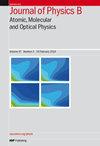小尺度原子结构计算中的目标优化:金 I 的应用
IF 1.5
4区 物理与天体物理
Q3 OPTICS
Journal of Physics B: Atomic, Molecular and Optical Physics
Pub Date : 2024-03-04
DOI:10.1088/1361-6455/ad2b71
引用次数: 0
摘要
缺乏可靠的原子数据会严重限制天体物理建模,尤其是千新星之类的事件,因为这些事件需要在广泛的电离阶段获得所有中子捕获元素的信息。值得注意的是,代表能量接近的构型的电子轨道之间存在非正交性,会给计算能量和转变概率带来很大误差。在此,我们提出了一种明确的目标优化(TO)方法,可以有效地规避这一问题,同时保留正交轨道基集。我们利用 Grasp2018 多构型 Dirac-Hartree-Fock 原子结构代码,在 Au I 的小尺度原子结构模型框架内说明了这种方法。通过与传统优化方案的比较,我们展示了 TO 方法如何改善能级定位和排序。对于最强的 E1 转变,TO 还能更好地与实验数据保持一致。这说明了如果仔细考虑轨道的非正交性,小尺度模型是如何以较小的计算成本得到显著改进的。这些结果将被证明对涉及中子捕获元素的天体物理不透明应用等方面的多元素原子结构计算有用。本文章由计算机程序翻译,如有差异,请以英文原文为准。
Targeted optimization in small-scale atomic structure calculations: application to Au I
The lack of reliable atomic data can be a severe limitation in astrophysical modelling, in particular of events such as kilonovae that require information on all neutron-capture elements across a wide range of ionization stages. Notably, the presence of non-orthonormalities between electron orbitals representing configurations that are close in energy can introduce significant inaccuracies in computed energies and transition probabilities. Here, we propose an explicit targeted optimization (TO) method that can effectively circumvent this concern while retaining an orthonormal orbital basis set. We illustrate this method within the framework of small-scale atomic structure models of Au I, using the Grasp2018 multiconfigurational Dirac–Hartree–Fock atomic structure code. By comparing to conventional optimization schemes we show how a TO approach improves the energy level positioning and ordering. TO also leads to better agreement with experimental data for the strongest E1 transitions. This illustrates how small-scale models can be significantly improved with minor computational costs if orbital non-orthonormalities are considered carefully. These results should prove useful to multi-element atomic structure calculations in, for example, astrophysical opacity applications involving neutron-capture elements.
求助全文
通过发布文献求助,成功后即可免费获取论文全文。
去求助
来源期刊
CiteScore
3.60
自引率
6.20%
发文量
182
审稿时长
2.8 months
期刊介绍:
Published twice-monthly (24 issues per year), Journal of Physics B: Atomic, Molecular and Optical Physics covers the study of atoms, ions, molecules and clusters, and their structure and interactions with particles, photons or fields. The journal also publishes articles dealing with those aspects of spectroscopy, quantum optics and non-linear optics, laser physics, astrophysics, plasma physics, chemical physics, optical cooling and trapping and other investigations where the objects of study are the elementary atomic, ionic or molecular properties of processes.

 求助内容:
求助内容: 应助结果提醒方式:
应助结果提醒方式:


